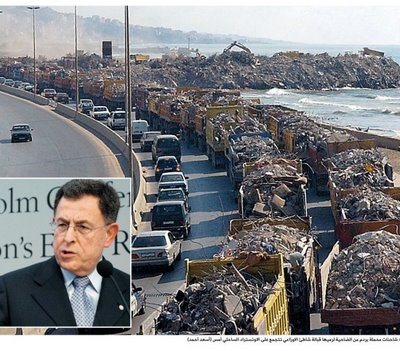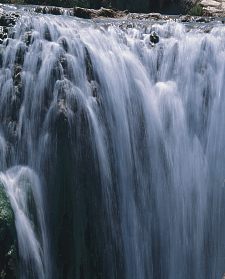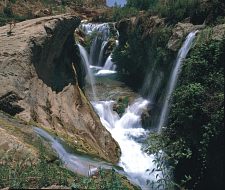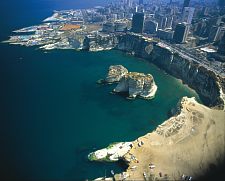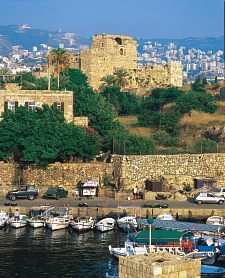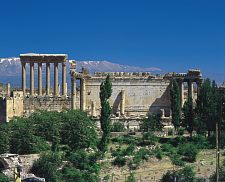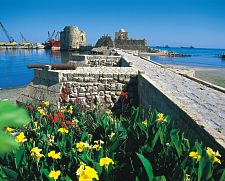Fuel oil loosed by israeli attack on Jiyyeh has badly fouled a national treasure
By Tom McCarthy Daily Star staff
BYBLOS: For at least 7,000 years, the hooked bay at the confluence of Lebanon's Darje Valley and the Mediterranean shore has hosted what is believed to be one of the oldest continuously inhabited settlements on Earth. Named Byblos by the Greeks, the modern-day site is famous for the visitor's ability to take in, over the course of a single afternoon, the layered traces of the many civilizations - Phoenician, Hellenistic, Roman, Crusader, Ottoman - that have displaced one another, often violently, on this most scenic and storied stretch of the Levantine coast. This July, in the early days of Israel's bombardment of Lebanon, yet another layer was added to Byblos' open-air archive of the march of history and its attendant bloodshed. Unlike previous editions, however, the most recent layer is not one that preservationists will be at pains to safeguard. On July 15, Israeli attacks on storage tanks at the Jiyyeh power plant south of Beirut sent 10,000 to 15,000 tons of fuel oil into the sea. It has been called the worst environmental disaster in Mediterranean history. Prevailing summer winds quickly carried the seaborne hazard northward. Days later, a sign of the seriousness of what had happened began to materialize 60 kilometers away from the source of the contamination. A tar-like, odorous film appeared on the quarried boulders that reinforce the Byblos jetty; on the white hulls of the dozens of fishing boats tied down in the city's old harbor; on the gravelly beaches stretching to Batroun to the north and Jounieh to the south; and, disturbingly, on the foundation stones of two of the site's historical treasures: the twin, 12th-century seafront towers built as a first line of defense by occupying Christian armies. Suddenly everything the water touched turned black. Last week the gleaming slime on the medieval towers was singled out by the United Nations Educational, Scientific and Cultural Organization (UNESCO) as "the most serious [cultural] damage resulting from the conflict," in a statement issued following a survey of Lebanon's five World Heritage Sites. "The vestiges of the ancient era - Phoenician, Hellenistic and Roman - situated underneath [the towers] are also covered with the same layer of oil," a separate, internal UNESCO report said. Due to its fragility, the site must be cleaned by hand, said the head of UNESCO's survey, Mounir Bouchenaki, in the statement. He estimated it would take 25 trained workers eight to 10 weeks to complete the job, at a cost of some $100,000. On the whole, UNESCO's reports following Israel's July-August bombardment of Lebanon did not contain the bad news that had been feared - of devastating damage to the Temple of Jupiter in Baalbek, for instance, or of similar damage to the Roman hippodrome or triumphal arch at Tyre. Both sites are in vicinities that suffered heavy fire for the duration of the war, however, and neither escaped injury. "Fissures on the lintels of the temples of Jupiter and Bacchus at [Baalbek] had probably widened because of vibrations from bombings nearby and warranted close monitoring," the UNESCO report said. In Tyre, meanwhile, "frescoes in a Roman tomb on the site had come partly unstuck, probably because of vibrations caused by bombs, and required emergency attention." The Tyre frescoes are only "200 meters from the closest bomb spot," a spokesperson at UNESCO's Beirut office told The Daily Star on Wednesday. "There was already a problem [with] their conservation. Additional shocking provoked further problems." The spokesperson - who agreed to speak on condition of anonymity, in place of UNESCO Beirut's official cultural spokesperson, Dr. Abdel Moneim Osman, who was traveling and could not be reached - was concerned that the relative lack of damage at the World Heritage Sites, which were the focus of UNESCO's work, would overshadow major damage at secondary sites across the country. "Somehow it is good news, but you have to be very careful, because unfortunately some heritage sites, not World Heritage Sites, were destroyed," the spokesperson said, mentioning sites in Bint Jbeil and homes in the old souk of Baalbek that took direct hits. "Of course we were glad because the World Heritage Sites are a universal, outstanding value to humanity, and it's good news," the spokesperson explained. "But it doesn't mean that some important sites were not damaged." At Byblos, the southern Crusader-era tower now oversees the narrow inlet to the modern-day harbor. On Tuesday evening, three fishermen stood on the exposed rock shelf seaward from the tower, casting over the margin of goop hugging the shoreline into the relatively clean water beyond. "About the fish there is no problem, because the fish can swim below," said one angler, a Byblos resident in his 20s who gave his name as Rawad and who boasted an almost-full creel as the sun neared the horizon. The tower itself, a rectangular structure of mismatched limestone and marble blocks swept with hardy grass and capped by a dilapidated archway, drops more than 10 meters - the height of 18 cut stones - into the sea on all sides. The tower is green with moss at its base, where limestone meets saltwater. And now it is black, too. In places the uniform coat of fuel oil rises 3 meters from the sea at low tide. Splatter marks on the stones above the solid field of sludge provide an abstract record of the sea's restlessness over the last two months. The UNESCO Beirut spokesperson said an attempt had already been made to clean the gunk from the towers, but that the usual power-washing methods had proved unworkable on the highly articulated stone, which has been degraded by nearly a millennium of exposure to the elements. "The dynamics of cleaning with the same equipment [as used on the modern port] gave a disturbing result," said the spokesperson. "For this reason it's necessary to work manually. We have to use brushes and we have to use a specific solution. Because there are stones underwater and we need to be very careful ... All the archaeological remains are quite fragile." A special cleaning solution must be developed because the compound clinging to the walls of the Byblos port is atypical of fuel-spill disasters, the spokesperson said. "In general, these kinds of catastrophes are always with crude oil. But the oil dumped from the power plant was already processed." The spokesperson said damage to the site will increase the longer the clean-up is delayed. "These kinds of old materials - limestone, mud - they have a big capacity [for] absorption," the spokesperson said. "So they must be cleaned soon." UNESCO has $70,000 available in an international emergency fund, one statement said, but it was unclear whether any of this money would be applied toward clean-up costs. "This is a complicated question," said the UNESCO official. "We'll see what will happen." What exactly has been lost in the damage to the ramparts of Byblos is difficult to qualify. If nothing else, the black slime now besmirching the tower walls is a miserable testament to humankind's failure to act as a caretaker of the past. The latest layer to be added to the Byblos archive is, quite literally, a stain on history.





